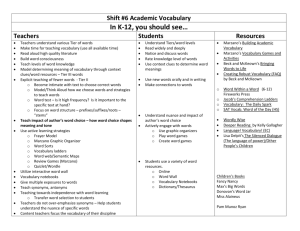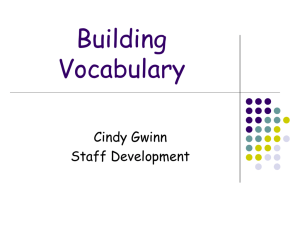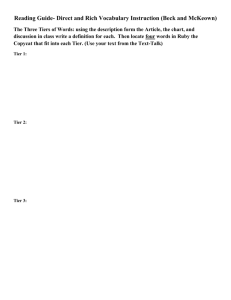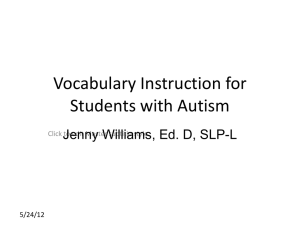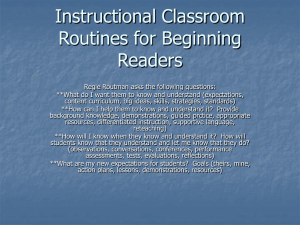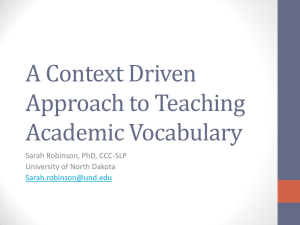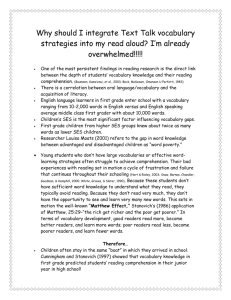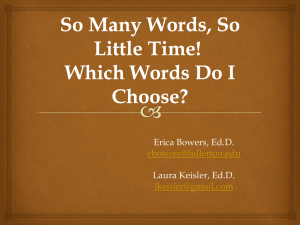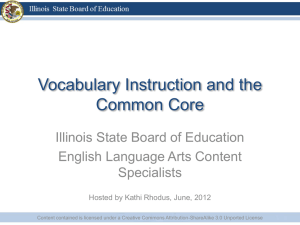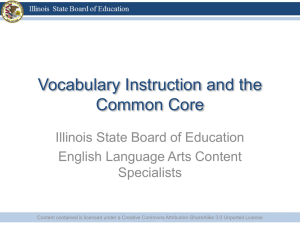SeptemberPresentationVocabulary-2
advertisement
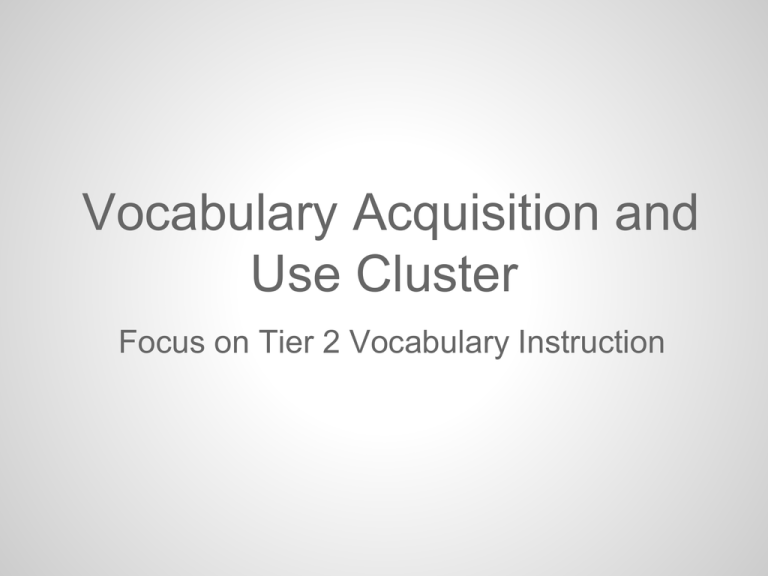
Vocabulary Acquisition and Use Cluster Focus on Tier 2 Vocabulary Instruction Please Remember: This workshop is a professional reminder that promotes consistency. • • • Give yourself credit for skills that you use consciously Make note of ideas that had gotten lost in the deluge Add new strategies to your repertoire - Hunter What are we currently doing with vocabulary instruction? Identify some ways that you are currently approaching vocabulary study in your classrooms this year? Why is this important? One of the best early predictors of comprehension is vocabulary. READING: Direct correlation between a student's vocabulary and reading comprehension(Beck and Mckeown 2007). WRITING: Breadth and depth of a student's vocabulary will have a direct influence upon the descriptiveness, accuracy, and quality of writing (Eddiger 1999). Two ways of increasing vocabulary: • • wide reading daily systematic direct instruction in context of reading OUTCOME: What we hope to achieve today: Teachers will walk away with some applicable strategies to effectively teach Tier 2 vocabulary in the classroom. This will help: • • Approach the VAU cluster Increase reading comprehension and improve student expression (speaking and writing.) 3 Tiers of Words (Beck and McKeown 2002) Tier One: Common words students encounter daily. (skinny, thin,) Tier Two: More complex words students encounter. (emaciated, waiflike) Tier Three: Words that are specific to content. (textual evidence, flashback, subplots) Why Tier 2 words now? Text Difficulty (complexity) Findings suggest that critical thinking void of complex texts was clearest indicator of students not meeting College Career benchmarks on ACT (ACT 2006). Be mindful of the complex texts students will encounter in college and career. Grade Band Old Lexile Ranges New Lexile ranges for the Core 6th to 8th Grade 860-1010 955-1115 9th-10th Grade 960-1115 1080-1305 11th Grade to College and Career 1070-1220 1215-1355 How to Identify Words • • • • Rich context Definition Antonym/(contrast) Synonym/(restatement) Tone of passage Think these types of words aloud with students. Model how to use context Most words have low frequency of context (Beck and Mckeown 2004). Lean context (majority of words) Direct Instruction may be needed • • Is it important for comprehension? Is it a "high mileage" word? (words used more frequently) (Beck and McKeown 2007) How to determine what words to teach? Leonard Pitts Passage: • • • Which words might be difficult for your students? Which have rich context? Which have lean context? Questions to consider: What context helped you with the determining the meaning of the word? What words did not have context? What to do once Tier 2 words have been identified? 1. Create your Word Wall (splash) 2. Determine level of knowledge. 3. Refine List for direct instruction 4. 5-10 words per week (Stahl and Fairbanks 1986). 5. Give students definitions 6. Students write definitions in own words 7. Depict through NonLinguistic representation 8. Word Play with Word Wall Utilizing Word Walls Example of how to determine knowledge of words Organizer I know the word I think I know the word I do not know the word Example graphic organizer (direct instruction) Example: WORD: _____________________ My Understanding of the Word: 1 2 3 4 5 Definition: My Definition of the Word: nonlinguistic representation: Why Non-Linguistic? • Easily accessible for strategy instruction • Helps target words for ELL students. • One of the 9 Instructional Strategies identified by Robert Marzano to have the highest impact on student achievement (Marzano 2001). Easy games to process Vocabulary: Taboo: Pictionary: Model for students how to create cards... Eventually students will create cards for the game rather than the teacher. Allows students to see multiple nonlinguistic representations of words Great way to review several elements of your classroom including vocabulary. Jeopardy: Other ways to process and use rich vocabulary Estimated 17 exposures or more to a word before it is truly internalized (Anderson & Nagy, 1992). 1. Teachers use on a frequent basis with students 2. Utilize other graphic organizers • Linear arrays (skinny...thin...emaciated) • Frayer Model (yes no examples) 3. Students utilize in daily language and writing. How do we know we have learned them? Students can and do utilize them orally in multiple contexts. Students can and do utilize them in writing in multiple contexts. Any other situation where the student is being asked to apply the word rather than to recite it. Look at Your Text... Look at your text and determine which words might be difficult for your students. Which have rich context? Which have lean context? THANK YOU FOR ALL YOUR WORK! The things taught in colleges and schools are not an education, but the means of education. Ralph Waldo Emerson Please visit the curriculum website to give feedback under Professional Learning www.kckliteracycurriculum.wikispaces.com
